
 |
|
|
|
|
| Belt Basin Shales | |
| The Belt Basin of western Montana, northern Idaho, and British Columbia/Alberta cotains a thick succession (possibly as much as 20 km) of Mid-Proterozoic terrigenous clastics and carbonates. J. Schieber has worked on the Belt Basin in the course of his dissertation and intermittently in the years since then. The Belt Basin contains an abundance of shales, and some of them were the subject of detailed study. A basic approach to shale studies is facies analysis, and the following slides summarize shale facies in the eastern portion of the Belt Basin. | |
|
Reference: Schieber, J., 1989, Facies and origin of shales from the Mid-Proterozoic Newland Formation, Belt basin, Montana, U.S.A.: Sedimentology, v. 36, p. 203-219. download PDF file (left click on link and click on "Save as"...) |
|
| From study of individual
stratigraphic slices in the Newland Formation of the eastern Belt
Basin, a model of lateral association of shale facies types can be
constructed. The Newland Formation and associated units were deposited in an east-west trending half-graben. |
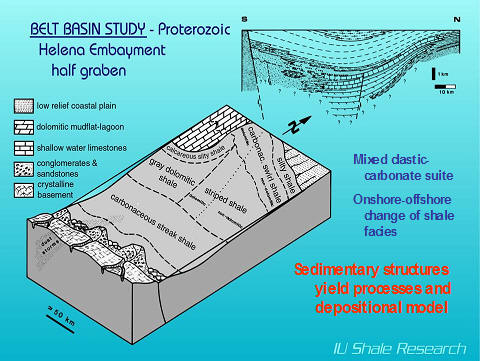 |
| Silty shales occur in nearshore settings, recording wave and current reworking of the substrate. |
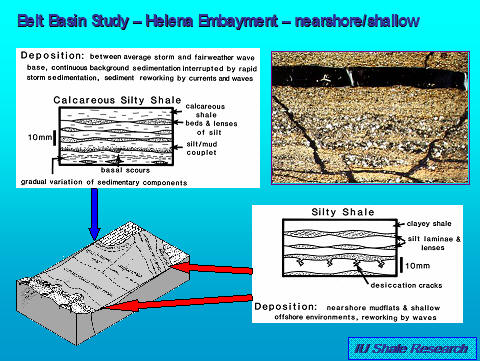 |
| In shallow offshore settings low angel truncations between shale beds are common (frequent erosive events. Thin deformed carbonaceous flakes are a common component. They are the eroded and buried fragments of benthic microbial mats. |
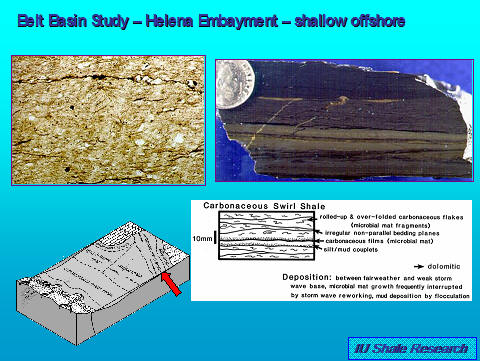 |
| Further offshore (erosive events infrequent) benthic microbial mats attain greater thickness and are interbedded with distal muddy tempestites (storm deposits). |
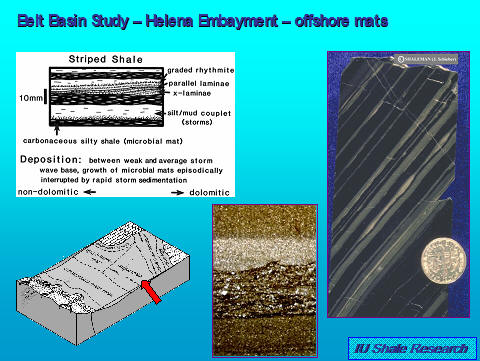 |
| Shales with thick benthic microbial mats have been described as "striped shales". Their recognition in various other Mid-Proterozoic successions indicates that offshore benthic mats were a vital part of Proterozoic ecology and important for the formation of carbonaceous shales and potential source rocks. |
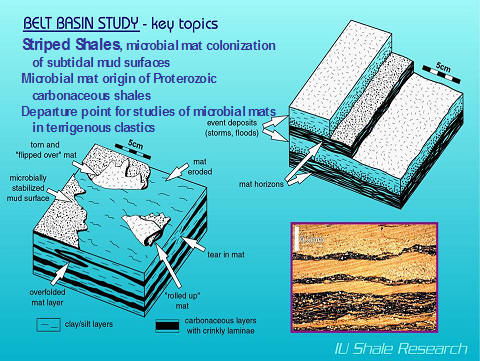 |
|
Reference for above: Schieber, J., 1986, The possible role of benthic microbial mats during the formation of carbonaceous shales in shallow Proterozoic basins: Sedimentology, v. 33, p. 521-536. download PDF file (left click on link and click on "Save as"...) |
|
| Further offshore deposition of calcareous muds may "overpower" benthic microbial mat growth. Whereas nearshore benthic mats may have been photosynthetic, deeper water offshore mats could quite possibly have been chemosynthetic, utilizing oxidation of hydrogen sulfide (from organic matter decomposition) as an energy source. |
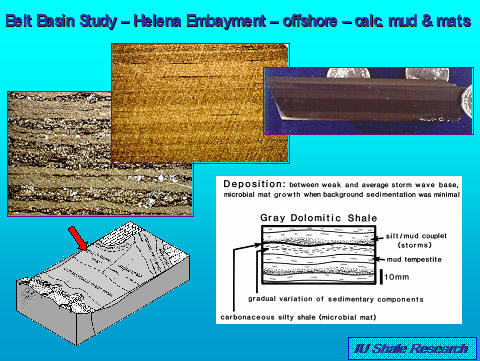 |
| In the central & deepest portion of the east-west trending trough, background sedimentation (terrigenous input from the southern faulted margin) is too frequent to allow establishment of benthic microbial mats. Organic matter mostly mat fragments washed in from shallower parts of the basin. |
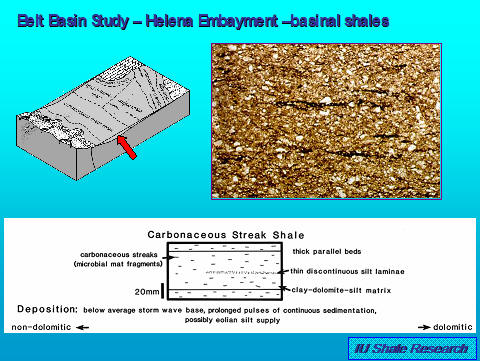 |
| Shale facies types in the eastern Belt Basin as a function of water depth/proximality and sediment input. |
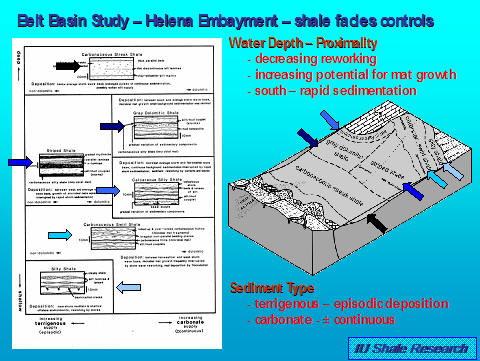 |
| A similar proximality-based approach can be employed for the red-green-gray shale successions of the western Belt Basin, such as the Missoula Group. |
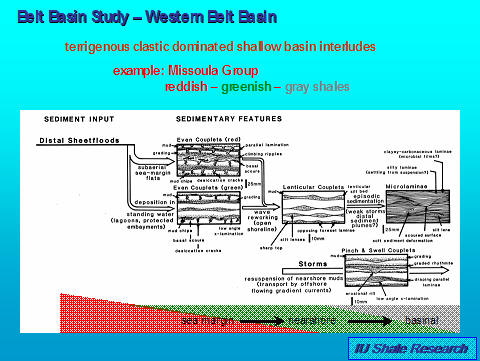 |
|
Reference for above: Schieber, J., 1990, Significance of styles of epicontinental shale sedimentation in the Belt basin, Mid-Proterozoic of Montana, U.S.A.: Sedimentary Geology, v. 69, p. 297-312. Associated PDF |
|
| For the basal portion of the western Belt Basin (Prichard Formation), sedimentary features suggest a mix of fluvial forcing, gravity driven deposition, bottom currents, and eolian input. |
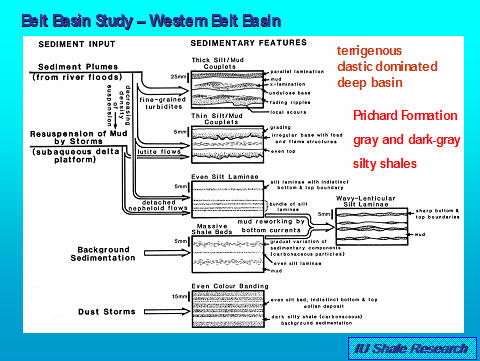 |
|
Reference for above: Schieber, J., 1990,
Sedimentary structures, textures, and depositional settings of
shales from the Lower Belt Supergroup, Mid-Proterozoic, Montana,
U.S.A.: In: Microstructure of Fine-Grained Sediments:
From Mud to Shale, (eds. R.H. Bennett, W.R. Bryant, M.H. Hulbert),
p. 101-108, Springer Verlag.
Associated PDF |
|
| Precambrian shales are unaffected by bioturbation, reflecting mainly physical processes of transport and deposition and superimposed effects of microbial mat colonization of the sediment surface. They were therefore the starting point for subsequent studies of younger shales where bioturbation overprinted the original physically based shale fabric to various degrees. |
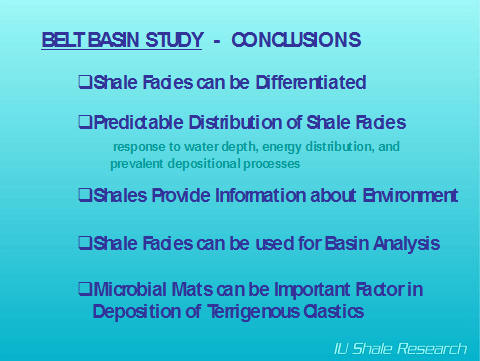 |
|
|
|
| Back to SHALE RESEARCH LAB Main Page | |
| Back to IU Department of Geological Sciences | |
|
© Jürgen Schieber, IU Bloomington Department of
Geosciences |
|